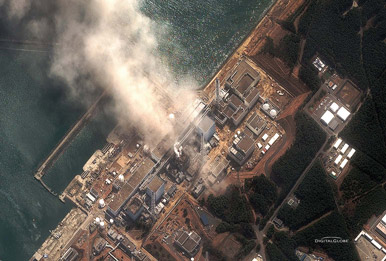after Fukushima
Ron Grant
 It’s not enough to engineer a safer facility.
It’s not enough to engineer a safer facility.
You also have to understand what happens in the environment, if things go wrong.
The earthquake and tsunami that disabled the Fukushima Daiichi Nuclear Power Station in March 2011 rocked the industry like a tidal wave.
“Once again, people were debating the risks and benefits of nuclear power,” says Timothy DeVol, a professor in Clemson’s nuclear environmental engineering and science (NEES) graduate program. “Right now countless industry professionals are trying to determine exactly what happened and how we can apply those lessons learned.”
At home in the environmental sciences, NEES researchers study nuclear power in an environmental context. What are the factors that affect the movement of plutonium and other radionuclides, the atoms involved in radiation? How can we develop better systems to detect and measure radiation? And how can we prepare the next generation of skilled engineers to guide a changing nuclear industry?
Today, South Carolina finds itself in the midst of a nuclear renaissance. The Department of Energy is building a $4 billion facility at the Savannah River Site (SRS) to dispose of surplus weapons-grade plutonium by converting it into fuel for nuclear power reactors. On the commercial side, Duke Energy and South Carolina Electric and Gas are both constructing nuclear plants, and companies are applying for twenty-year extensions on licenses for reactors that began operating in the late 1970s and 1980s. In Burke County, Ga., just across the river from SRS, the Southern Company has begun site preparation for two new units at its Vogtle facility.
Detective work
“All of these locations present different challenges in terms of spent-fuel storage, high-level waste, and legacy materials,” says the newest NEES faculty member, Lindsay Shuller-Nickles. “If you are a nuclear researcher and educator, Clemson is the place to be.”
-
During the Fukushima crisis, Clemson alumni applied their expertise. A few examples:
David Brown (M.S., 1993) is a senior health physicist with the U.S. Nuclear Regulatory Commission (NRC), where he applies lessons learned in Japan to the development of new requirements for U.S. reactors.
Andrew Scott (MS/Ph.D., 2010) is a nuclear weapons effects analyst with the U.S. Army. After the tsunami, he developed recommendations and policies designed to protect service members working in Japan.
Aurelie Soreefan (Ph.D., 2009) is the radioanalytical technical director with the U.S. Air Force Radiations Analysis Laboratory, at Wright-Patterson Air Force Base in Ohio. Soreefan reorganized work in the lab to make Fukushima sampling a priority.
Andrew Sowder (Ph.D., 1998), a senior project manager with the Electric Power Research Institute in Charlotte, N.C., is part of a team of industry and government experts who tried to understand what was occurring at the Fukushima plant and what mitigating measures might be prudent.
![]() on the job
on the job
Shuller-Nickles and her students are evaluating the release of radionuclides into the environment and their subsequent mobility. If radionuclides escape containment, how will they react with local groundwater and minerals? And how will different forms of waste change over time?
Three years after completing his Ph.D., Brian Powell returned to Clemson to lead a program in environmental radiochemistry. He studies the behavior of radionuclides to learn how to clean up sites contaminated during nuclear-weapons production and how to evaluate nuclear-waste disposal sites. Powell’s data could show, for instance, when nuclear waste would find a safer resting place outside of South Carolina.
In other cases, researchers work to improve the storage of waste already here. As part of its cleanup effort, SRS asked for data on the performance of engineered barriers used in radionuclide disposal. NEES researchers are providing it. (On-site disposal of waste costs approximately ten percent of what would be charged for off-site disposal.)
With two grants from Department of Homeland Security, NEES is building up its training program in radioanalytical chemistry and establishing a nuclear forensics program in collaboration with national laboratories. The research will focus on water-system monitoring and changes in nuclear fuel particles after release into the environment. Another project will deploy fifty lysimeters—instruments for tracking precipitation and the movement of water—to follow plutonium and other key radionuclides under natural conditions for ten years.
Such studies are especially timely, DeVol says, because many of the issues facing the industry today have to do with radioactive contaminants in the environment.
“While a Fukushima-type event correctly gives us pause,” says DeVol, “it is our responsibility as nuclear educators and researchers to apply lessons learned and continue a tradition of service, safety, and reliability.”
NEES is a part of the Department of Environmental Engineering and Earth Sciences in the College of Engineering and Science. Timothy DeVol was recently named the Toshiba Endowed Professor in Nuclear Engineering.


